In October and November 2011 we are undertaking a month-long collaborative research project off the island of Hawai‘i. The research team includes Aran Mooney of Woods Hole Oceanographic Institution (WHOI), Russ Andrews of the University of Alaska Fairbanks/Alaska SeaLife Center, Aliza Milette of the University of Hawai‘i, Dan McSweeney of the Wild Whale Research Foundation, and Jessica Aschettino, Greg Schorr, Daniel Webster and Robin Baird of Cascadia. Like most of our field projects we have a number of research goals. Our primary funding for this project comes from grants from the Office of Naval Research (ONR), through WHOI, and the National Oceanographic Partnership Program (NOPP), through the Alaska SeaLife Center. The NOPP grant (primarily funded by ONR) focuses on follow up of previously satellite tagged individuals and using a Forward Looking Infra Red (FLIR) camera to examine circulation in the dorsal fin of tagged individuals, while the ONR grant is to study the acoustic behavior of melon-headed whales and false killer whales using suction-cup attached DTags (Digital acoustic tags). In addition to those primary goals, we will be deploying satellite tags on a number of species to examine movements and habitat use, obtaining identification photos of a number of species of toothed whales and dolphins to assess abundance and social organization, as well as collecting biopsy samples for genetic and toxicology studies.
All photos are copyrighted and should not be used without permission.
End of project update
November 13 was our last day on the water. We covered 3,993 kilometers in 27 days on the water (with two boats operating on six of the days), and had 101 sightings of 13 species of odontocetes. Our most frequently encountered species were pantropical spotted dolphins (27 sightings), closely followed by short-finned pilot whales (26 sightings). Most unusual for the trip were the large number of sightings of dwarf sperm whales (10 groups, the third most frequently-sighted species), Cuvier’s beaked whales (6 sightings) and pygmy killer whales (6 sightings). Prior to this trip, over our 12-year field effort, these three species have ranked as the 6th, 7th, and 13th most frequently encountered species, respectively, so sighting rates have been unusually high. As well as taking over 35,000 photos for individual identification, and collecting 19 biopsy samples, we deployed 17 satellite tags (on 6 species), obtained FLIR images of many tagged and previously tagged individuals, and deployed DTags on a short-finned pilot whale, several melon-headed whales, and a false killer whale from the Hawai‘i insular population. All-in-all a good trip.
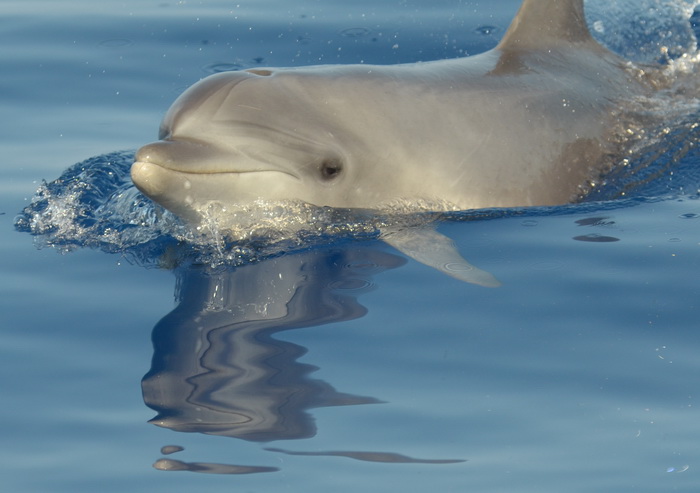
Bottlenose dolphin, November 13, 2011. Photo (c) Russ Andrews.
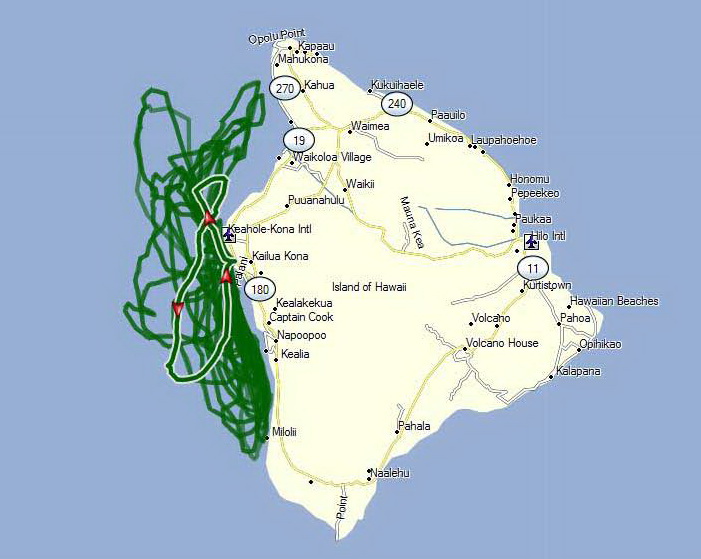
Our vessel tracklines for the trip, with our last day (November 13, 2011) highlighted. We spent 27 days on the water (six with two vessels simultaneously), covering almost 4,000 kilometers of trackline.

Bottlenose dolphin, November 13, 2011. Photo (c) Aran Mooney
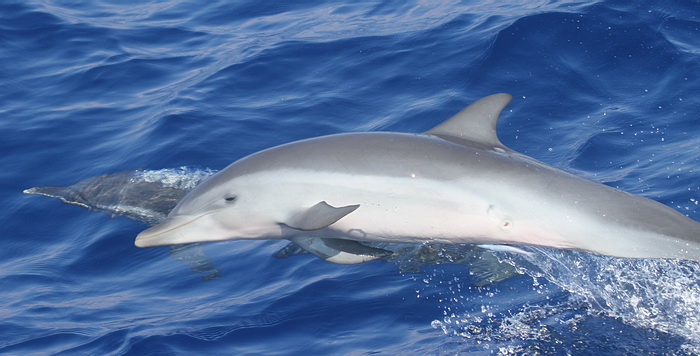
Juvenile pantropical spotted dolphin leaping next to an adult, November 13, 2011. Photo (c) Jessica Aschettino. Note the remora on the belly of the dolphin.
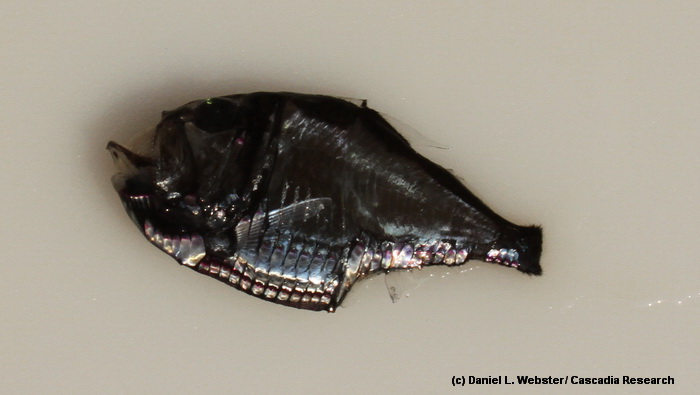
Hatchetfish found floating at the surface, November 13, 2011. Photo (c) Daniel Webster
November 11, 2011 update
In the last two days we’ve had encounters with pantropical spotted dolphins, rough-toothed dolphins, and Cuvier’s beaked whales.
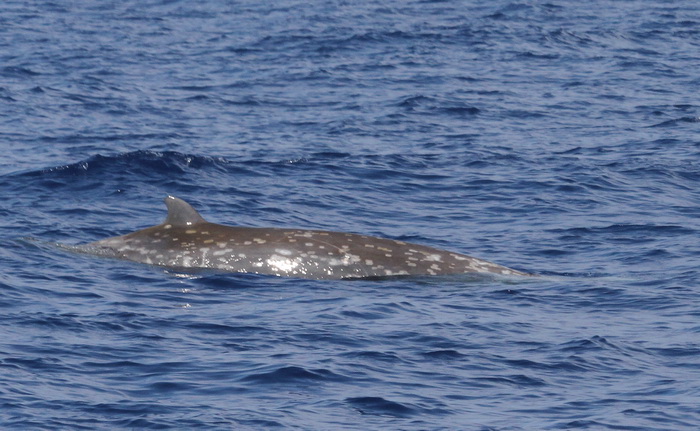
Adult female Cuvier’s beaked whale, November 10, 2011. Photo (c) Jessica Aschettino. On November 10 we encountered two Cuvier’s, an adult female, and a calf thought to be less than a year and a half old. The adult female is a well-known individual from the resident population (HIZc007 in our catalog), having been documented on seven previous occasions between 2004 and 2010. Our last encounter with HIZc2010 was in April 2010 – during that encounter we deployed a satellite tag and tracked her movements and dive behavior over a week-long period (download a report on results from that work here) – no calf was present during that encounter, so the calf was born some time after that encounter.
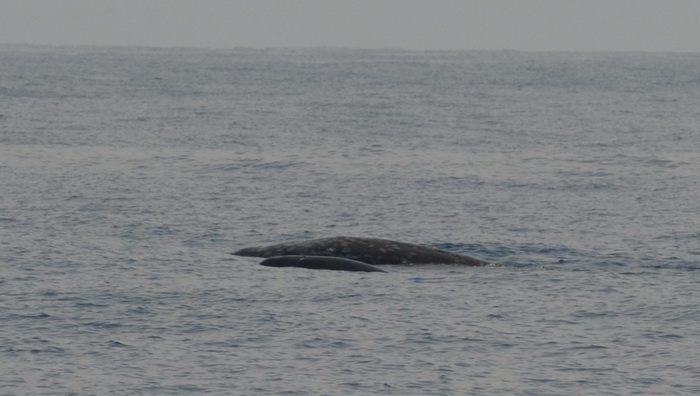
Mother and calf Cuvier’s beaked whales logging at the surface, November 11, 2011. Photo (c) Russ Andrews. These two individuals are the same two seen November 10, 2011.
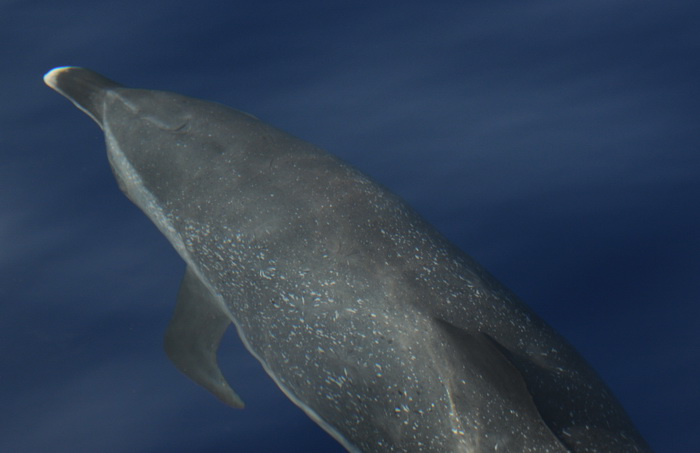
Bowriding pantropical spotted dolphin, November 11, 2011. Photo (c) Aran Mooney. As well as photo-identifying individual spotted dolphins we are also collecting biopsy samples for several studies, including a study of microbes by Amy Apprill at Woods Hole Oceanographic Institution. Very little is known about the microbial community associated with marine mammals, yet these microbes may provide important information about the health or ecology of the animals. The skin samples collected from marine mammals during this field work will be used for a novel investigation of their associated bacterial community. Amy is using DNA-based molecular-type techniques, including the latest in ‘next generation’ sequencing technology to study these microbes. From just a single skin sample, she is able to generate ~10,000 sequences of a ribosomal gene region that provides information about the identity of the associated bacteria. Comparisons of bacterial communities between individuals, populations and across diverse species will help in the understanding of how these communities are structured, and what factors may be influencing this structure.

Pantropical spotted dolphins wake-riding, November 10, 2011. Photo (c) Aran Mooney
November 9, 2011 update
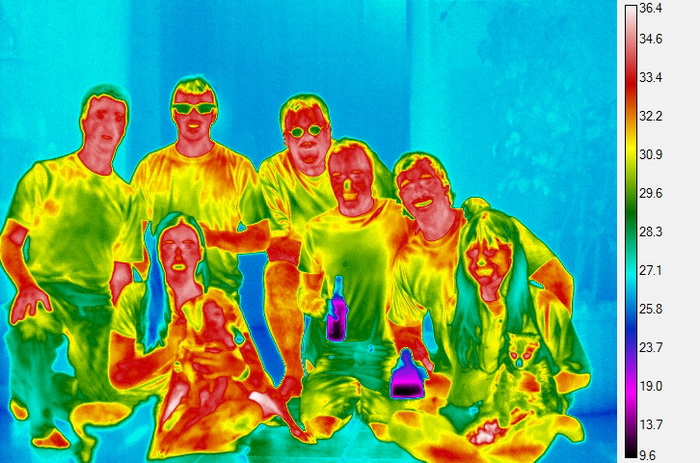
A FLIR (Forward Looking InfraRed) image of the “Wild Whale” research crew. From left to right: Russ Andrews, Jessica Aschettino (with Dexter), Daniel Webster, Robin Baird, Aran Mooney, Greg Schorr, Aliza Milette. We are using the FLIR to image the dorsal fin of tagged and non-tagged pilot whales and other species, to assess the potential influence of the tags on dorsal fin circulation.
In the last week we’ve had 22 sightings of four species of odontocetes, including four sightings of pygmy killer whales. We’ve deployed one satellite tag (on a short-finned pilot whale), obtained a lot of photos for individual photo-identification, and collected five biopsy samples for genetics and toxicology studies.
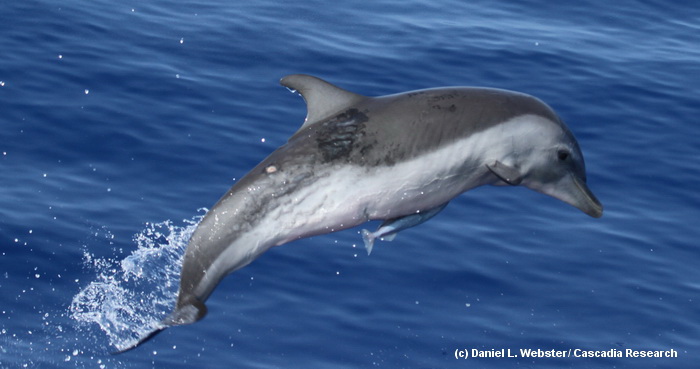
Juvenile pantropical spotted dolphin leaping in an attempt to remove a remora, November 8, 2011. The skin lesions below and behind the dorsal fin are likely from persistent remora presence. Photo (c) Daniel Webster

A group of pantropical spotted dolphins, including a neonate, with the faint fetal folds visible, November 8, 2011. The neonate has a partially healed bite wound from a cookie-cutter shark on its flank. Photo (c) Jessica Aschettino
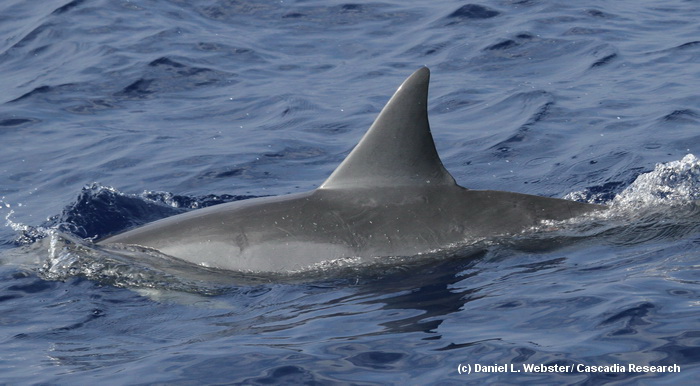
Spinner dolphin, seen with a group of pantropical spotted dolphins offshore of Kona, November 8, 2011. Photo (c) Daniel Webster. This is the same individual that we documented offshore with spotted dolphins both in August 2011 and May 2011, suggesting this association may be a long-term one. In August 2011 this individual was seen with a small calf in close attendance, but the calf was not with the spinner dolphin November 8, 2011.
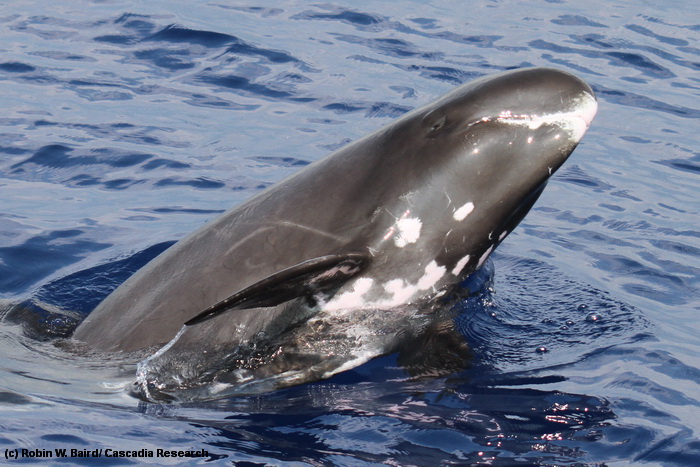
Pygmy killer whale breaching, November 6, 2011. Photo (c) Robin Baird. The white scars on the belly of this individual are healed scars from cookie-cutter shark bites. We had four sightings of pygmy killer whales over a three-day period, including re-sightings of a pair of individuals present in three of the four sightings.

A white-necked petrel, November 3, 2011. Photo (c) Daniel Webster
November 2, 2011 update
In the last few days we’ve re-deployed the HARP, and have had 14 encounters with six species of odontocetes: four groups of dwarf sperm whales (three today alone!), two groups of pantropical spotted dolphins, three groups of short-finned pilot whales, two groups of Cuvier’s beaked whales, and one group each of melon-headed whales and spinner dolphins. We’ve also had nice sightings of a tiger shark and some interesting seabirds.

Dwarf sperm whales off Kona, November 2, 2011. Photo (c) Greg Schorr. The adult female on the right with the well-marked fin is HIKs020 in our photo-identification catalog. She was first documented off the island in 2004, and was seen in 2006, twice in 2008, and in 2009 (see a photo of her and a calf from October 30, 2009 on our October/November 2009 project web page).
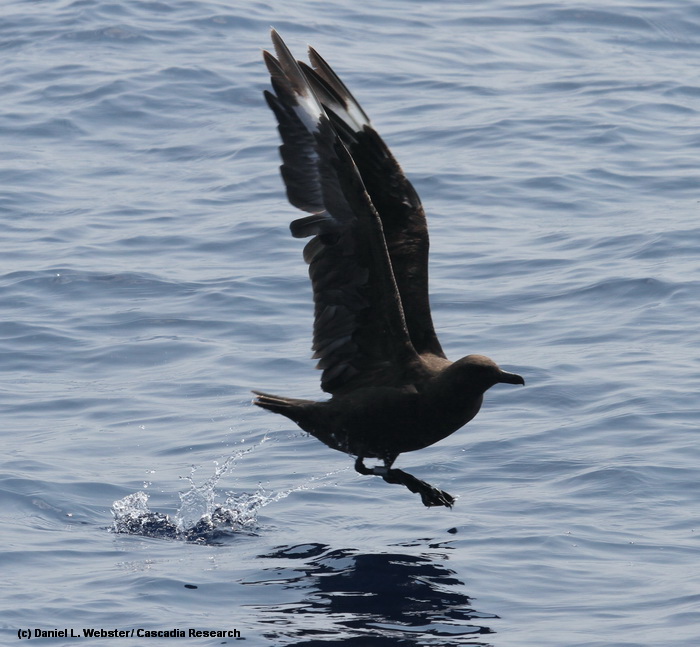
A banded South Polar Skua, November 2, 2011. Photo (c) Daniel Webster.

Wake-riding pantropical spotted dolphins, November 2, 2011. Photo (c) Jessica Aschettino.
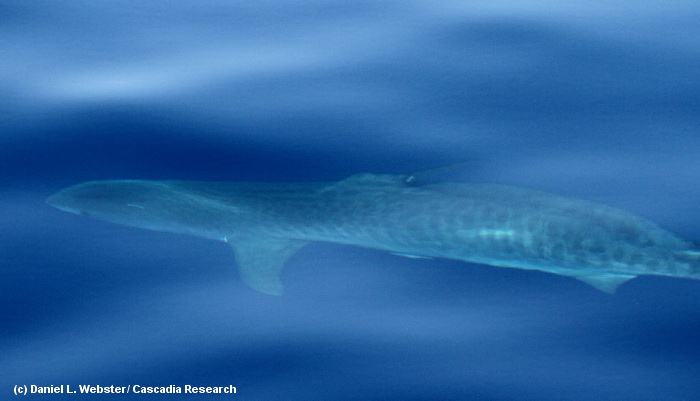
Tiger shark off Kona, November 1, 2011. Photo (c) Daniel Webster
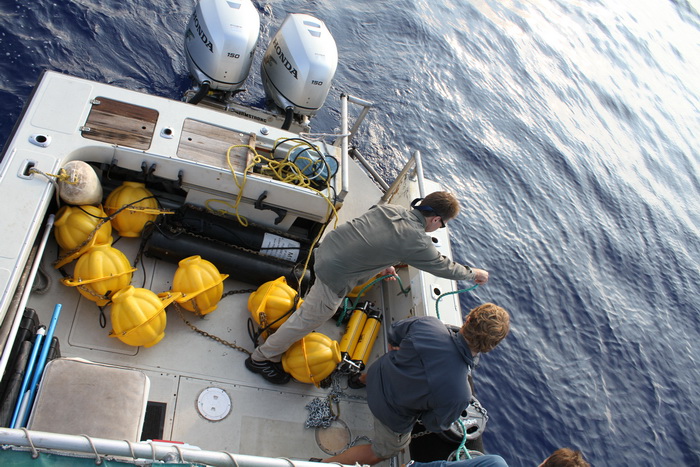
Deploying the HARP, November 1, 2011. Photo (c) Robin Baird. For more information on the information being recorded by the HARP see a report written up on preliminary results from November 2010.
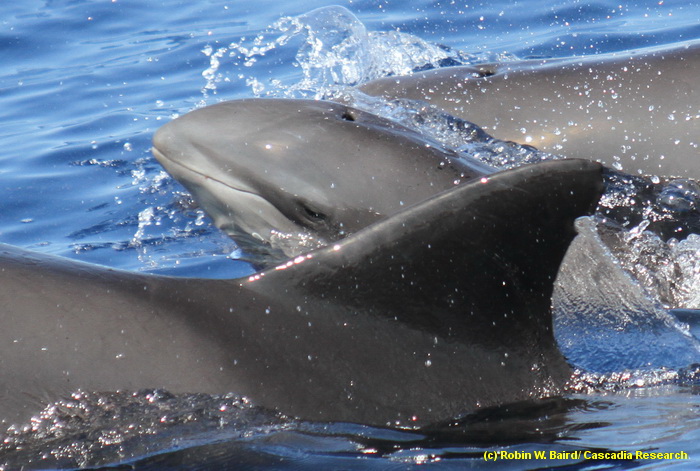
Melon-headed whale mother and infant, October 31, 2011. Photo (c) Robin Baird.
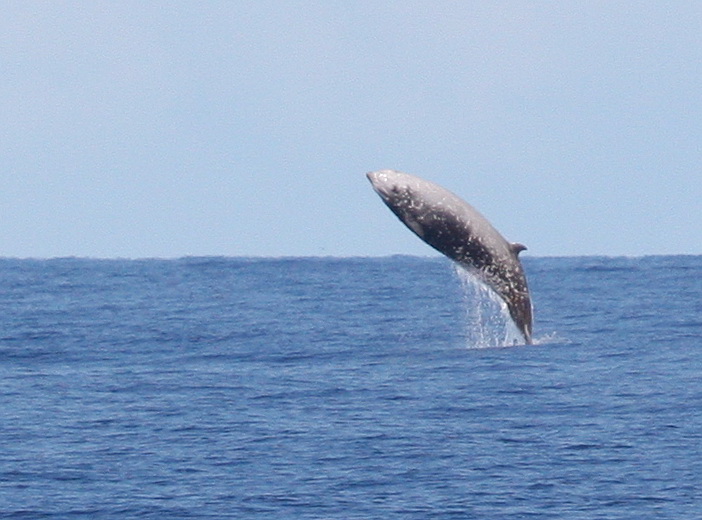
Breaching Cuvier’s beaked whale, October 31, 2011. Photo (c) Jessica Aschettino
October 29, 2011 update
In the last few days we’ve collected four more squid, recovered the HARP (High-frequency Acoustic Reporting Package) deployed off Kona earlier in the year, encountered more striped dolphins and rough-toothed dolphins, and obtained more FLIR images of tagged and untagged short-finned pilot whales.

Rough-toothed dolphins, October 29, 2011. Photo by Daniel Webster

Mottled petrel, October 29, 2011. Photo by Daniel Webster.
October 26, 2011 update
Today we encountered our highest priority species for the trip, false killer whales. Early in the morning we encountered a group of about 16 false killer whales from the Hawaii insular population, about 10% of the entire population. We were able to photo-identify most of the individuals, we deployed one satellite tag, and also deployed (and recovered) a Dtag.
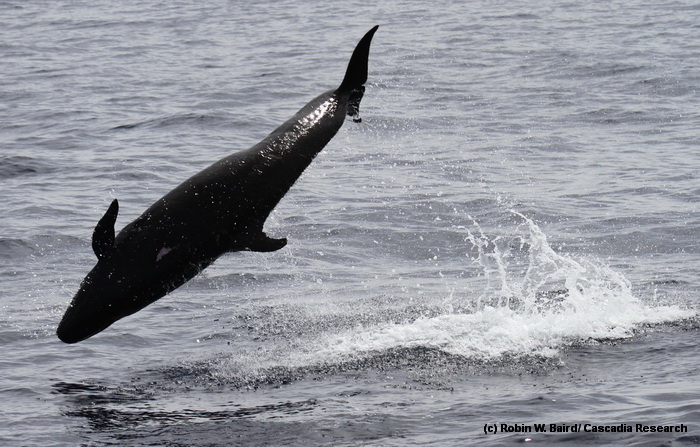
False killer whales regularly leap out of the water when they are chasing prey, which makes them easy to spot at a distance – we were 3.2 kilometers from this group when we first spotted them. Photo (c) Robin Baird, October 26, 2011.

False killer whale and mahi mahi – the mahi mahi was thrown out of the water during the attack. Photo (c) Jessica Aschettino, October 26, 2011. We witnessed five predation events during the encounter, four on mahi and one on a large unidentified fish.
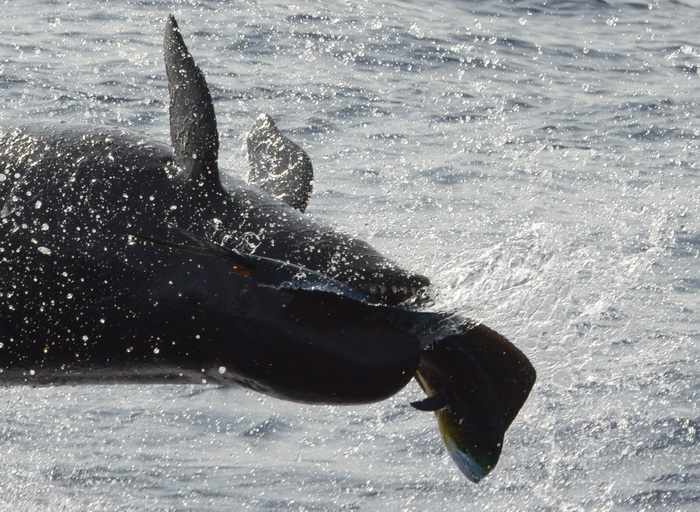
False killer whale with mahi mahi, October 26, 2011. Photo (c) Russ Andrews
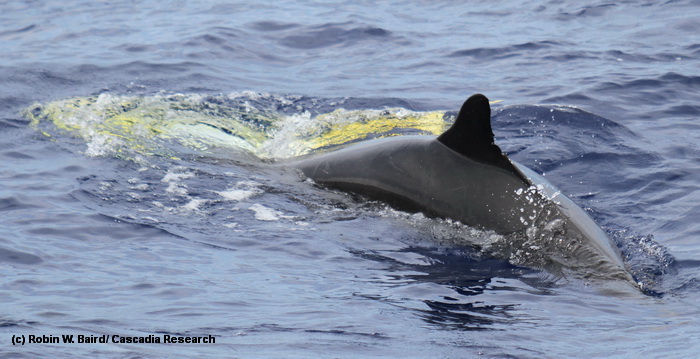
False killer whale with a very large mahi mahi. Photo (c) Robin Baird
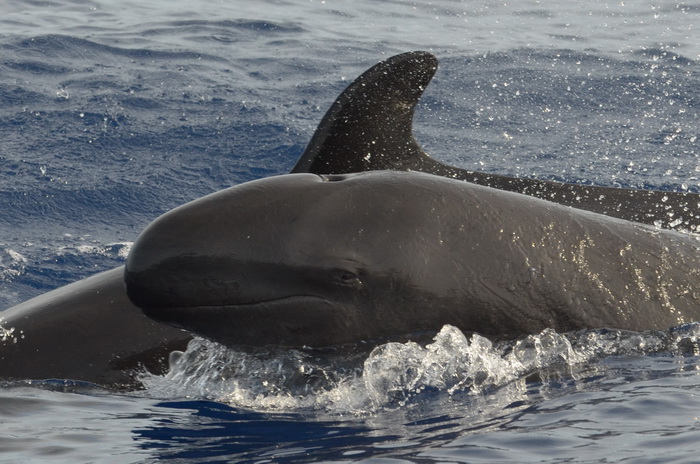
False killer whale mother and calf, October 26, 2011. Photo (c) Russ Andrews
October 25, 2011 update
In our 8 days on the water (albeit with two boats for five of the days) we’ve had 37 sightings of 12 species of odontocetes. Six of these sightings have been of dwarf sperm whales – tied for the second-most frequently encountered species of the trip, so far. Quite amazing given how difficult this species is to detect. Today we encountered a group of about 7 dwarf sperm whales, including three mother/calf pairs and one lone (large) adult, probably an adult male. We were able to photo-identify all the individuals present.
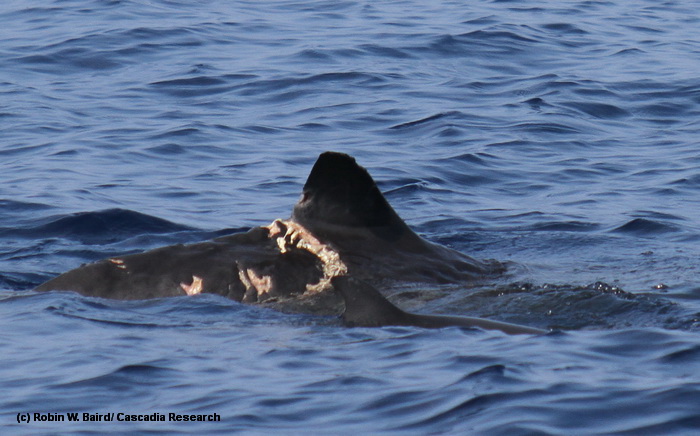
A mother and calf pair of dwarf sperm whales off Kona, October 25, 2011. Photo (c) Robin Baird. The large wound behind the dorsal fin of the adult female is from a large shark, probably a tiger shark.
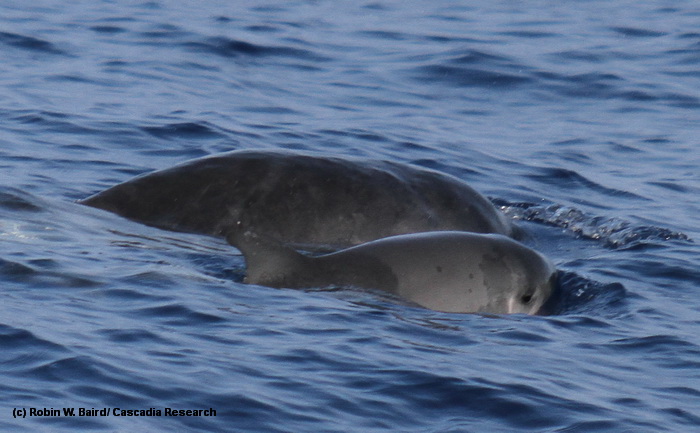
Mother and calf pair of dwarf sperm whales, October 25, 2011. Photo (c) Robin Baird
October 24, 2011 update
Using information from the satellite tags we deployed earlier in the trip, today we encountered a group of about 300 melon-headed whales from the Hawai‘i Island resident population.
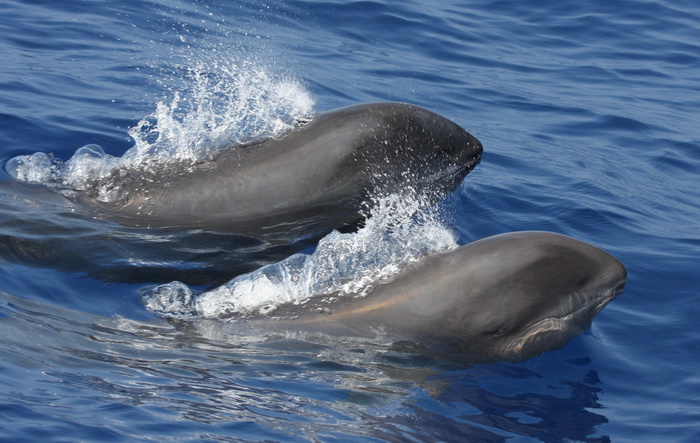
Melon-headed whales, October 24, 2011. Photo (c) Jessica Aschettino. We were able to photo-identify more than half the individuals present, and also deployed a Dtag.
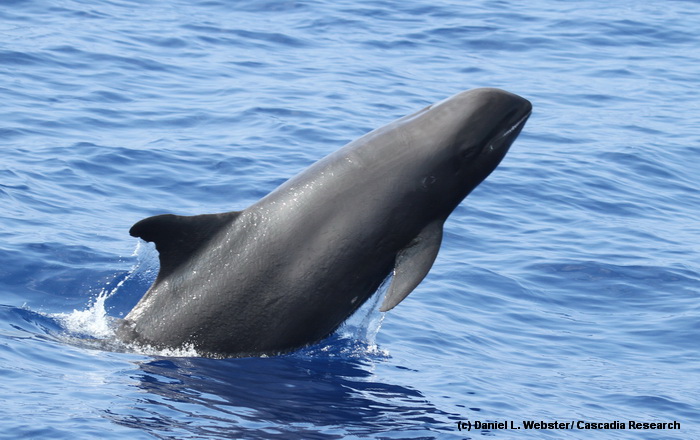
Melon-headed whale leaping, October 24, 2011. Photo (c) Daniel Webster
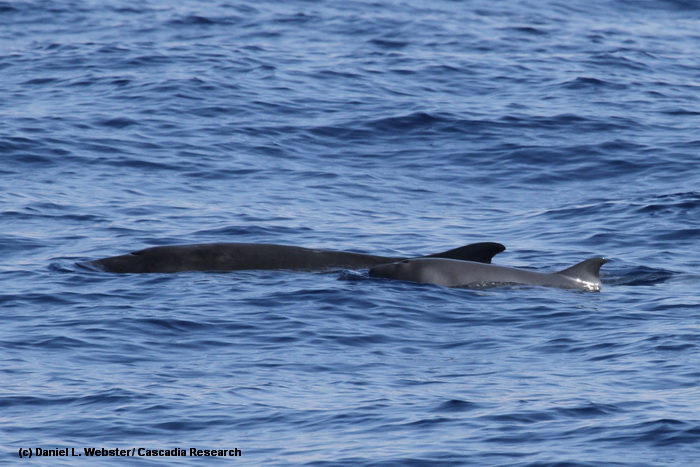
Two dwarf sperm whales, October 24, 2011. Photo (c) Daniel Webster. We also encounterd three dwarf sperm whales, including this mother and calf pair, as well as a probable adult male (based on the size). The male was quite distinctive and we will compare it to our photo-identification catalog to see if it is a member of the resident population. For more information on dwarf sperm whales see our web page web page on this species.
October 23, 2011 update

Close up of the head of an adult male Blainville’s beaked whale, October 23, 2011. Photo (c) Daniel Webster. Today we encountered two new species for the trip (bringing the total so far to 12 species of odontocetes), including a group of about 9 Blainville’s beaked whales. This individual is an adult male – the tip of the left tooth is just visible, and both teeth are covered by stalked barnacles. We were able to photo-identify several individuals (and recognize one, an adult female, that we’ve seen several times in the past), and deployed a satellite tag on the adult male to track its movements. We are able to identify this as an adult male both by the teeth and the extensive linear scarring typical of adult male Blainville’s. This individual is actually missing a fair amount of tissue behind the blow hole, probably caused by fighting with other male Blainville’s. For more information on beaked whales see our web page for beaked whales in Hawaii.
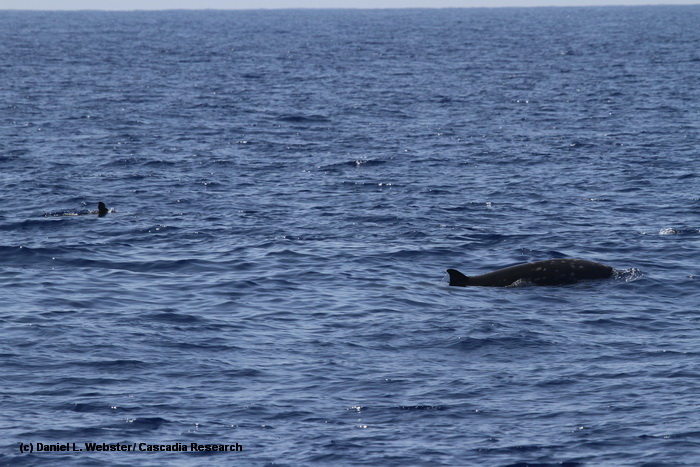
The typical distance that we see most beaked whales at – this photo was taken with a lens at 310 mm focal length (~6 times magnification) and is not cropped. Photo (c) Daniel Webster, October 23, 2011.
October 22, 2011 update

A dwarf sperm whale off Kona, October 22, 2011. Photo (c) Aliza Milette. Today we encountered a pair of dwarf sperm whales. This species has a reputation for avoiding boats, but in fact is just very unpredictable in it’s surfacing patterns. We followed the group for 25 minutes and photo-identified both individuals, then left to continue our search.
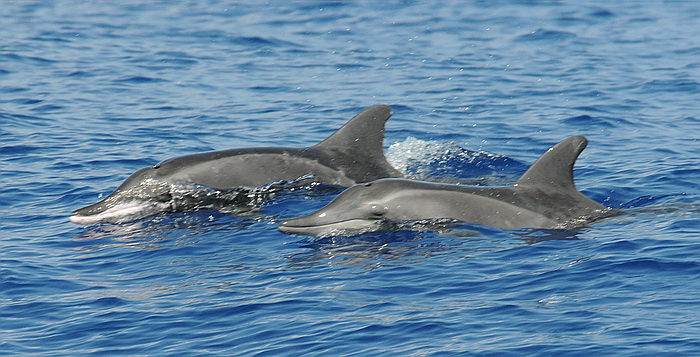
A pair of rough-toothed dolphins, photo (c) Aran Mooney. We encountered two new species of odontocetes for the trip today (bringing the total for the trip to 10 so far), including two groups of rough-toothed dolphins – we were able to collect one biopsy sample and photo-identify most of the individuals present.

A FLIR image of a short-finned pilot whale. Photo (c) Russ Andrews. We also encountered two groups of pilot whales, including individuals we tagged on previous days this trip. We were able to photo-identify all the individuals present as well as obtain FLIR images to examine circulation in the dorsal fin of tagged and untagged individuals.
October 21, 2011 update
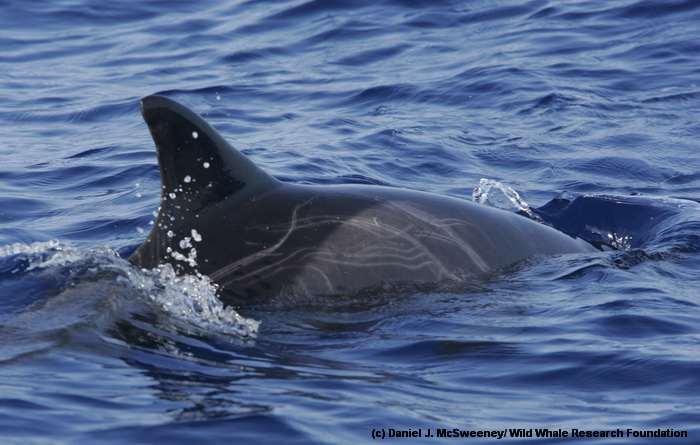
A well-marked pygmy killer whale, October 21, 2011. Photo (c) Dan McSweeney. Today we encountered our second group of pygmy killer whales for the trip. Normally we encounter this species only every couple of weeks so two sightings in four days has given us an opportunity to get identification photos of far more individuals than we normally get during such periods. For more information on pygmy killer whales see our web page for that species.

An olive ridley sea turtle off Kona, October 21, 2011 (with thanks to George Balazs for species confirmation). Photo (c) Daniel Webster. Sea turtles are surprisingly rare in offshore waters off the Kona coast – today we encountered the first olive ridely sea turtle we have seen in Hawaiian waters.
October 20, 2011 update
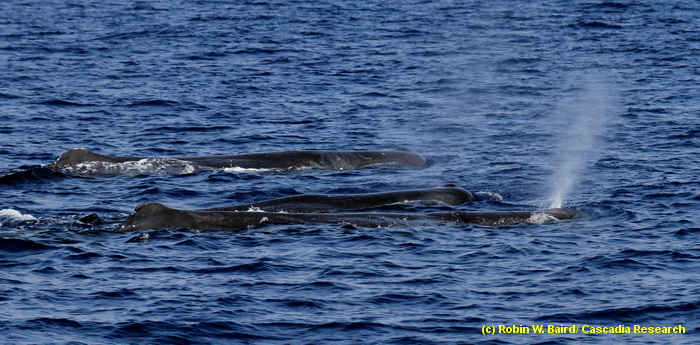
Sperm whales off Kona, October 20, 2011. Photo (c) Robin Baird. Today we encountered four species of odontocetes, including one new species for the trip, a group of about 25 sperm whales. We were able to deploy two satellite tags to track movements.
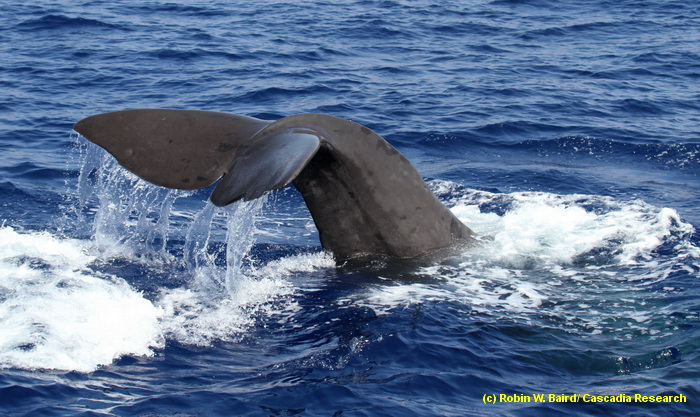
Sperm whale fluking, October 20, 2011. Photo (c) Robin Baird. Normally individual sperm whales are identified by fluke photographs, but in Hawaiian waters they rarely fluke when they dive, so we also obtain dorsal fin photos for our photo-identification catalog.
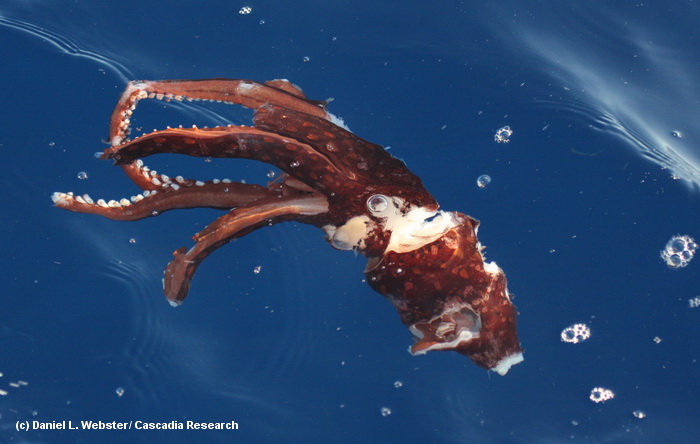
Squid found today off Kona, October 20, 2011. Photo (c) Daniel Webster. We collect all floating squid, to help identify prey available in the area for deep-diving odontocetes, as well as for stable isotope analyses.
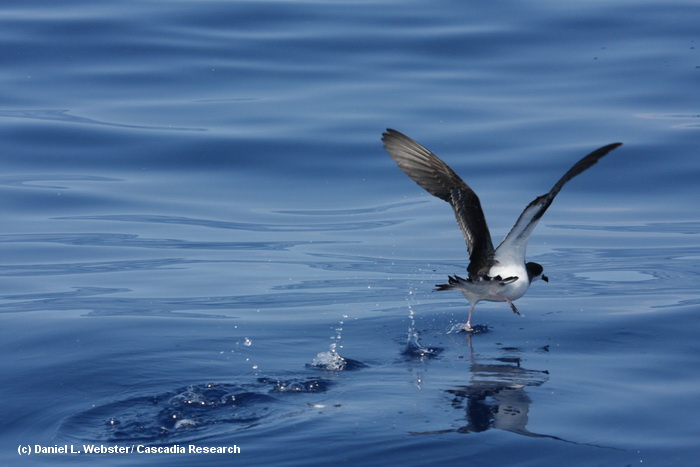
Hawaiian petrel, October 20, 2011. Photo (c) Daniel Webster.
October 19, 2011 update

Striped dolphin, October 19, 2011. Photo (c) Daniel Webster
Our second day on the water was also quite productive, with five sightings of five species, including four new species for the trip. We encountered a small group of striped dolphins (~5 individuals) in relatively shallow water, ~1600 m deep. We see this species commonly in deep water (>3500 m) offshore of Kona, but rarely in such shallow water. For more information on striped dolphins in Hawaii see our web page for that species.
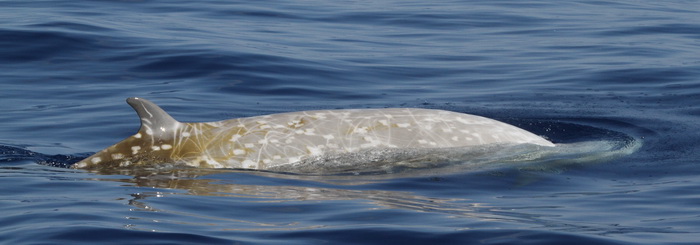
Adult male Cuvier’s beaked whale, October 19, 2011. Photo (c) Aliza Milette. We also encountered a group of three Cuvier’s beaked whale, including this adult male (identifiable as an adult male by the large number of linear white scars, caused by fighting with other adult males). We were able to photo-identify all three individuals and deployed a satellite tag (one that transmits both location and dive data) on one individual.

Bow-riding melon-headed whale, October 19, 2011. Photo (c) Jessica Aschettino. We also encountered a group of approximately 350 melon-headed whales, members of the Hawai‘i Island resident population, and were able to photo-identify about half the group, and also deployed two satellite tags (one location-only and one location/dive tag), as well as the first Dtag deployment on a melon-headed whale. Although the tag only stayed on about half an hour, it did record a variety of acoustic and behavioral information.

Melon-headed whale, October 19, 2011. Photo (c) Jessica Aschettino.
October 18, 2011 update

Short-finned pilot whale spyhopping, October 18, 2011. Photo (c) Daniel Webster
Today was our first day on the water for the trip and we used both the 27′ Whaler and the 21′ whaler, with the two vessels surveying in opposite directions. Between the two boats we covered ~240 km, and had six sightings between them, of three different species. We encountered two groups of short-finned pilot whales, and were able to deploy two satellite tags on individuals in each of the two groups.

Short-finned pilot whale with satellite tag, October 18, 2011. Photo (c) Greg Schorr.

Pygmy killer whale off Kona, October 18, 2011. Photo (c) Aliza Milette
We also encountered a rare species for the area, a group of four pygmy killer whales, and were able to get identification photos of at least three individuals. (October 19 update: we’ve matched these three individuals to our catalog – all three have previously been seen on two occasions, all together off this island in 2000 and 2006).
Off the north Kona coast we also had a very good day for sightings of seabirds, with ~20 different petrel sightings, including Hawaiian petrels and black-winged petrels, as well as a South Polar Skua.

Black-winged petrel off Kona, October 18, 2011. Photo (c) Aliza Milette
some photos from previous projects showing a FLIR image
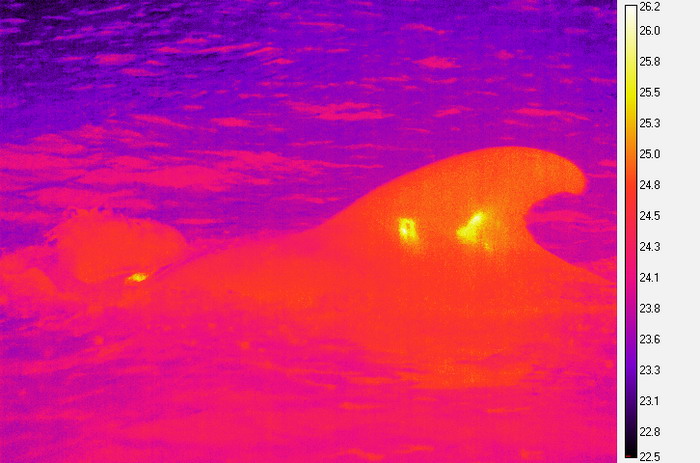
A FLIR image from a pilot whale from our April/May 2009 project. This individual has not been previously tagged, but has two areas with elevated skin temperature. The scale on the right side is in degrees Celcius.
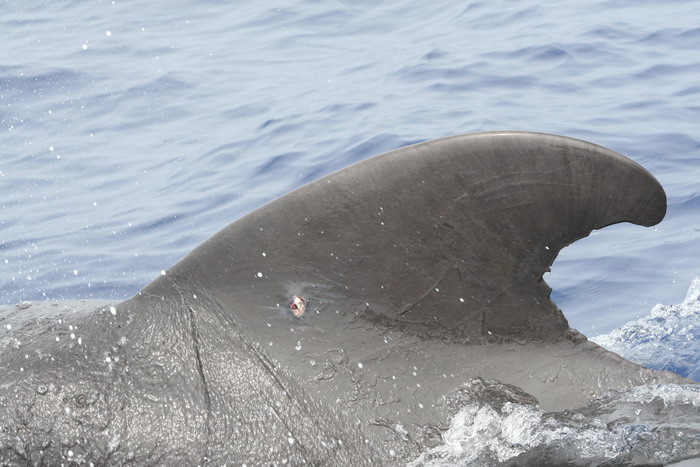
The adult male pilot whale whose dorsal fin was imaged with the FLIR above. Photo (c) Jessica Aschettino. The wound on the fin is probably a healing bite wound from a cookie-cutter shark.
All photographs on this page are copyrighted and are not to be used without permission.
Sign up to our Facebook page if you want to receive notices of when information is posted and updates on other Cascadia projects.